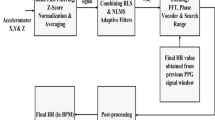Abstract
In order to improve the accuracy of heart rate extracted from wearable photoplethysmography (PPG) signal, a new processing method based on moving average filtering is proposed. There are two cascaded moving average filters. The first filter is designed to remove baseline wandering as preprocessing. The second filter whose window size is adjusted according to the additional accelerometer signal is used to remove motion artifacts. During continuous monitoring, the parameters of these two filters change adaptively in accordance with a batch processing method. The results show that the proposed method can reconstruct a better waveform and improve the signal quality for calculating the beats per minute (BPM). Referenced with the vital sign monitoring instrument VS800 of Mindray company, the detecting accuracy of the proposed method is 7%–10% higher than adaptive filtering.
Access this chapter
Tax calculation will be finalised at checkout
Purchases are for personal use only
Similar content being viewed by others
References
Tamura, T., et al.: Wearable photoplethysmographic sensors—past and present. Electronics 3(2), 282–302 (2014)
Millasseau, S.C., et al.: Contour analysis of the photoplethysmographic pulse measured at the finger. J. Hypertens. 24(8), 1449–1456 (2006)
Lee, Y., et al.: Development of a wristwatch-type PPG array sensor module. In: 2011 IEEE International Conference on Consumer Electronics-Berlin (ICCE-Berlin) (2011)
Budidha, K., Kyriacou, P.A.: The human ear canal: investigation of its suitability for monitoring photoplethysmographs and arterial oxygen saturation. Physiol. Meas. 35(2), 111–128 (2014)
Ming-Zher, P., Swenson, N.C., Picard, R.W.: Motion-tolerant magnetic earring sensor and wireless earpiece for wearable photoplethysmography. IEEE Trans. Inf. Technol. Biomed. 14(3), 786–794 (2010). A Publication of the IEEE Engineering in Medicine & Biology Society
Sweeney, K.T., et al.: Artifact removal in physiological signals-practices and possibilities. IEEE Trans. Inf Technol. Biomed. 16(3), 488–500 (2012). A Publication of the IEEE Engineering in Medicine & Biology Society
Han, H., Kim, J.: Artifacts in wearable photoplethysmographs during daily life motions and their reduction with least mean square based active noise cancellation method. Comput. Biol. Med. 42(4), 387–393 (2011)
Gibbs, P.T., Wood, L.B., Asada, H.H.: Active motion artifact cancellation for wearable health monitoring sensors using collocated MEMS accelerometers. In: Proceedings of SPIE - The International Society for Optical Engineering, vol. 5765, pp. 811–819 (2005)
Lee, B., et al.: Improved elimination of motion artifacts from a photoplethysmographic signal using a Kalman smoother with simultaneous accelerometry. Physiol. Meas. 31(12), 1585–1603 (2010)
Shi Ping, Y.H.: Principles of photoplethysmography and its applications in physiological measurements. J. Biomed. Eng. 30(4), 899–904 (2013)
Allen, J.: Photoplethysmography and its application in clinical physiological measurement. Physiol. Meas. 28(3), R1–39 (2007)
Zhang, Z.: Photoplethysmography-based heart rate monitoring in physical activities via joint sparse spectrum reconstruction. IEEE Trans. Biomed. Eng. 62(8), 1902–1910 (2015)
Lee, J.: Motion artifacts reduction from PPG using cyclic moving average filter. Technol. Health Care Official J. Eur. Soc. Eng. Med. 22(3), 409–417 (2014)
Lee, H.W., et al.: The periodic moving average filter for removing motion artifacts from PPG signals. Int. J. Control Autom. Syst. 5(6), 701–706 (2007)
Yousefi, R., Nourani, M., Panahi, I.: Adaptive cancellation of motion artifact in wearable biosensors. In: Conference: International Conference of the IEEE Engineering in Medicine & Biology Society IEEE Engineering in Medicine & Biology Society Conference (2012)
Hui, L., Dai, B.Q., Wei, L.: A pitch detection algorithm based on AMDF and ACF. In: IEEE International Conference on Acoustics (2006)
Author information
Authors and Affiliations
Corresponding author
Editor information
Editors and Affiliations
Rights and permissions
Copyright information
© 2017 ICST Institute for Computer Sciences, Social Informatics and Telecommunications Engineering
About this paper
Cite this paper
Chen, Y., Li, D., Li, Y., Ma, X., Wei, J. (2017). Use Moving Average Filter to Reduce Noises in Wearable PPG During Continuous Monitoring. In: Giokas, K., Bokor, L., Hopfgartner, F. (eds) eHealth 360°. Lecture Notes of the Institute for Computer Sciences, Social Informatics and Telecommunications Engineering, vol 181. Springer, Cham. https://doi.org/10.1007/978-3-319-49655-9_26
Download citation
DOI: https://doi.org/10.1007/978-3-319-49655-9_26
Published:
Publisher Name: Springer, Cham
Print ISBN: 978-3-319-49654-2
Online ISBN: 978-3-319-49655-9
eBook Packages: Computer ScienceComputer Science (R0)




